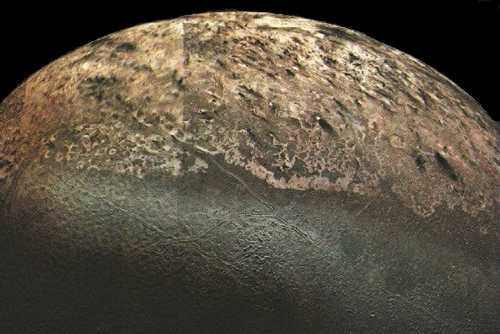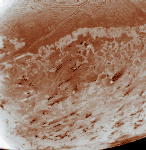
 |
orbit: 354,760 km from Neptune
diameter: 2700 km
mass: 2.14e22 kg
Discovered by Lassell in 1846 only a
few weeks after the discovery of Neptune itself.
In Greek mythology, Triton is a god of the sea, the son of Poseidon (Neptune); usually portrayed as having the head and trunk of a man and the tail of a fish.
Triton has been visited by only one spacecraft, Voyager 2 on Aug 25 1989. Almost everything we know about it comes from this encounter.
Triton's orbit is retrograde. It is the
only large moon to orbit "backwards", the only other moons with
 retrograde orbits are Jupiter's
moons Ananke,
Carme,
Pasiphae and
Sinope and
Saturn's
Phoebe all of which are less than 1/10 the diameter
of Triton.
Triton could not have condensed from the primordial
Solar Nebula in
this configuration; it must have formed elsewhere
(perhaps in the Kuiper Belt?)
and later been captured
by Neptune (perhaps involving a collision with another now shattered Neptunian moon).
A capture scenario could account not only for Triton's orbit but also
for the unusual orbit of
Nereid and provide the energy needed to melt and
differentiate Triton's interior.
retrograde orbits are Jupiter's
moons Ananke,
Carme,
Pasiphae and
Sinope and
Saturn's
Phoebe all of which are less than 1/10 the diameter
of Triton.
Triton could not have condensed from the primordial
Solar Nebula in
this configuration; it must have formed elsewhere
(perhaps in the Kuiper Belt?)
and later been captured
by Neptune (perhaps involving a collision with another now shattered Neptunian moon).
A capture scenario could account not only for Triton's orbit but also
for the unusual orbit of
Nereid and provide the energy needed to melt and
differentiate Triton's interior.
Because of its retrograde orbit, tidal interactions between Neptune and Triton remove energy from Triton thus lowering its orbit (and speeding up Neptune's rotation). At some very distant future time it will either break up (perhaps forming a ring) or crash into Neptune.
The unusual nature of Triton's orbit, the similarity of bulk properties between Pluto and Triton, and the highly eccentric, Neptune-crossing nature of Pluto's orbit suggest some historical connection between them. Exactly what this might be is purely conjecture at this time however.
Triton's axis of rotation is also unusual, tilted 157 degrees with respect to
 Neptune's axis (which is in turn inclined
30 degrees from the plane of
Neptune's orbit). This adds up to an orientation with respect to the
Sun somewhat like Uranus's
with polar and equatorial regions alternately pointing toward the Sun.
This probably results in radical seasonal
changes as one pole then the other moves into the sunlight.
During the Voyager 2 encounter, Triton's
south pole was facing the Sun.
Neptune's axis (which is in turn inclined
30 degrees from the plane of
Neptune's orbit). This adds up to an orientation with respect to the
Sun somewhat like Uranus's
with polar and equatorial regions alternately pointing toward the Sun.
This probably results in radical seasonal
changes as one pole then the other moves into the sunlight.
During the Voyager 2 encounter, Triton's
south pole was facing the Sun.
Triton's density (2.0) is slightly greater than that of Saturn's icy moons (e.g. Rhea). Triton is probably only about 25% water ice with remainder rocky material.
Voyager found that Triton has an atmosphere, albeit a very tenuous one (about 0.01 millibar), composed mostly of nitrogen with a small amount of methane. A thin haze extends up 5-10 km.
The temperature at the surface of Triton is only 34.5 K (-235 C, -391 F), as cold as Pluto. This is due in part to its high albedo (.7 - .8) which means that little of the Sun's meager light is absorbed. At this temperature methane, nitrogen and carbon dioxide all freeze solid.
 There are
very few craters visible; the surface is
relatively young. Almost the
entire southern hemisphere is covered with an "ice cap" of frozen nitrogen and
methane (right).
There are
very few craters visible; the surface is
relatively young. Almost the
entire southern hemisphere is covered with an "ice cap" of frozen nitrogen and
methane (right).
There are extensive ridges and valleys in complex patterns all over Triton's surface. These are probably the result of freezing/thawing cycles.
The most interesting (and totally unexpected)
 features of this unusually interesting world are the
ice volcanoes. The eruptive material is probably
liquid nitrogen, dust, or methane compounds from beneath the surface.
One of Voyager's images shows an actual plume rising 8 km
above the surface and extending 140 km "downwind" (left).
features of this unusually interesting world are the
ice volcanoes. The eruptive material is probably
liquid nitrogen, dust, or methane compounds from beneath the surface.
One of Voyager's images shows an actual plume rising 8 km
above the surface and extending 140 km "downwind" (left).
Triton, Io and Venus are the only bodies in the solar system besides Earth that are known to be volcanically active at the present time (though Mars clearly was in the past). It's also interesting to note that very different volcanic processes occur in the outer solar system. Earth's and Venus' (and Mars') eruptions are of rocky material and are driven by internal heat. Io's eruptions are probably sulfur or sulfur compounds driven by tidal interactions with Jupiter. Triton's eruptions are of very volatile compounds like nitrogen or methane driven by seasonal heating from the Sun.
![]() ... Neptune
... Proteus
... Triton
... Nereid
...
... Neptune
... Proteus
... Triton
... Nereid
... ![]()
![]()